Day 4
Outside Santiago and on to the coast... |
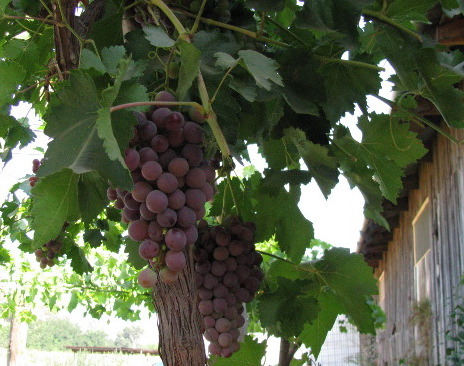 |
We visited a family
run vegetable farm that grew from small, seasonal sales to selling
year round to major Chilean supermarkets. It was a family of 5 and
the father had worked hard, had put his children through college,
and they were back working on the farm. One son had an ag degree and
had married a gal who was a veterinarian. We toured the farm and
were invited to mom and dad's new house for cookies and drinks.
|
|
Leaving the farm we
drove northwest through the Curacavi and Casablanca Valleys where we
saw raspberries, blueberries and vineyards. The climate changed as
we passed through the coastal mountains going to Valparaiso and Vina
del Mar. It became cooler and foggy. |
|
Named Paradise Valley, Valparaiso is called "Valpo" by the locals and is one of that country's most important and oldest seaports. The city is located in central Chile, where it is capital of the Region of Valparaiso. Although Santiago is Chile's official capital, Valparaiso houses the National Congress. Built upon several hillsides overlooking the Pacific Ocean, Valparaiso embodies a rich architectural and cultural legacy and is protected as a UNESCO World Heritage Site. |
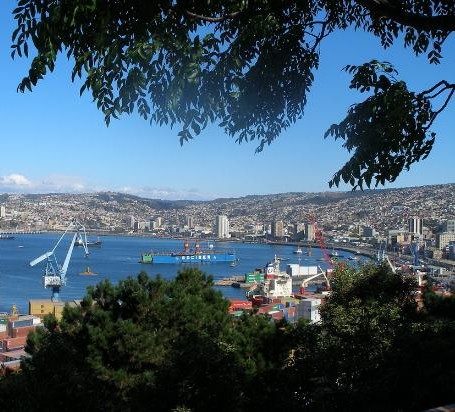 |
 |
Valparaiso and Vina
del Mar are coastal cities built on cerros (hills). The houses were
colorful and built on steep hills, some not
accessible by auto, but by stairs. It was foggy and dreary most of
the time we were there.
Vina del Mar, meaning "Vineyard of the Sea", is a Chilean coastal city in the Valparaiso Region. As Chile's fourth largest city, it is best known as a tourist and beach destination. |
|
We ate at a restaurant
sitting on rocks over looking the ocean. Watching the seaweed go
back and forth with the waves was fascinating. |
|
We started out with
Pisco Sours on the patio overlooking the sea and the rocks. In the
restaurant we had a platter of sea food as an appetizer. Our main
meal was conger eel on veggies. It is a long ugly fish that lives in
the rocks, but it was very good and did not taste like fish. We
finished off with dessert and coffee. |
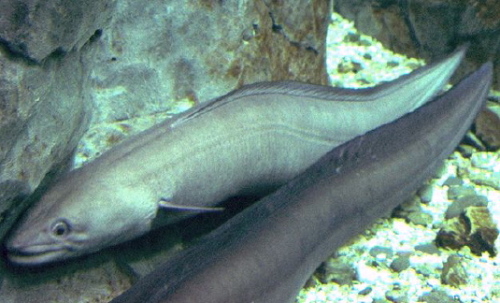 |
|
We drove around the
two cities, which were full of vacationers, and drove back to
Santiago. The Chileans usually take a month vacation during
February. They rent a house up in this area and stayed there during
that time just relaxing. |
|
We arrived back at our
hotel about 6:30 pm.
The lady, Karen
Gerbes, who had lost her luggage became ill and had to go to the
hospital. Her husband would stay with her. Terry took Karen to a
German hospital during the night. |
 |
Temuco is the administrative capital of the Araucania Region. The name comes from "temu", from the Mapudungun language. It is a tree used by Mapuches for medicinal purposes. The city is located south of Santiago and is near lake-based resort centers, making it a hub for visitor excursions.
Today we flew to
Temuco, which is the granary of Chile and the cultural center of the
Mapuche Indians, Chile's original inhabitants. Our flight was
about an hour from Santiago and uneventful. |
|
We were taken to our
hotel, Terraverde Hotel Temuco, which we discovered was not
air-conditioned. We opened the windows and the door for a while and
the room was quite comfortable. For lunch we had fish soup, chicken with
veggies and strawberry mousse.
After lunch the bus took us down town and we walked around with Jim
and Ruth Goldman from Arizona. There was an open air market around
the plaza and I bought a scarf pin. It being Sunday not much else
was open. We did stop at a grocery store and bought some fruit. We
walked back to the hotel and it was hot. Jim and Jim bought a drink
of fruit and some grain. It was sweet, but not all that good;
however, several locals were buying it.
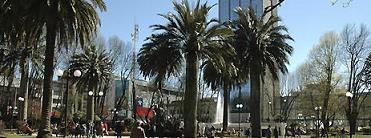
|
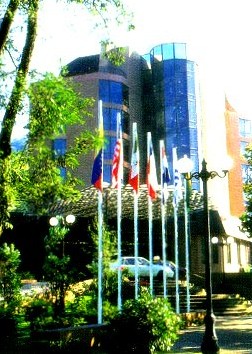
It
was super bowl night and several of the group watched the game in the
lounge of the hotel. Jim and I stayed in the room and rested. |
Day 6
Outside Temuco and on to Vladivia... |
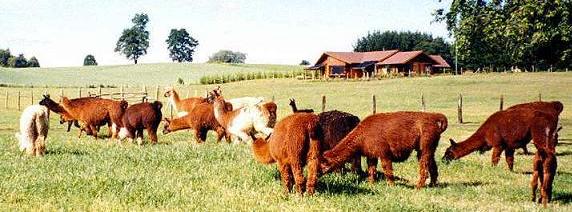 Llama del Sur Ranch Llama del Sur Ranch |
We left the hotel at
8:00 am and drove to Llamas del Sur, a farm run by the von Baer
family. They have been breeding llamas, alpacas and guanacos on
their small farm since 1989. |
|
The mother and daughter run the farm
while dad works in Temuco and visits on weekends. |
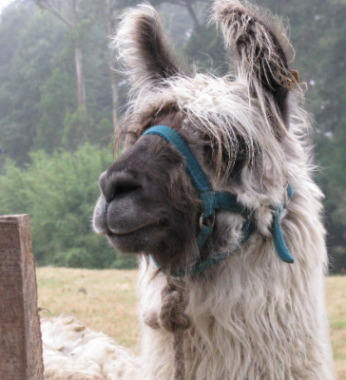 Llama Llama |
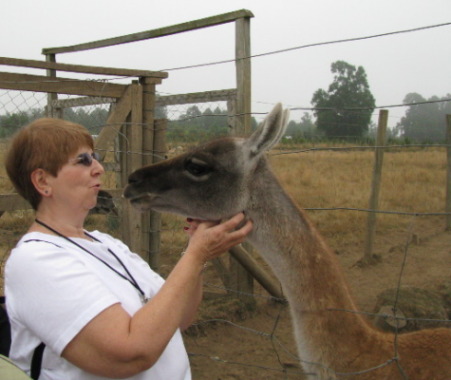 Guanaco Guanaco |
|
The day was cool and
foggy but it didn't stop us from having a great time seeing all the
animals and enjoying the family. We were able to pet the animals and
watch them in the fields. Two male guanacos put on a rival show by
spitting at each other.
I bought a black
shawl, made out of llama wool hand made by Indians. |
|
Next we drove to a
Mapuche Indian farm. The woman welcomes tour groups to make a little
extra money for her family. They sang and danced for us and then
wanted us to sing for her. We sang Amazing Grace.
The Indians fix their
food over an open fire in a hut with a thatched roof. They had on a
big kettle of lard and fixed us fry bread and other food. The food
was ok and no one got sick. It was a heavy snack. |
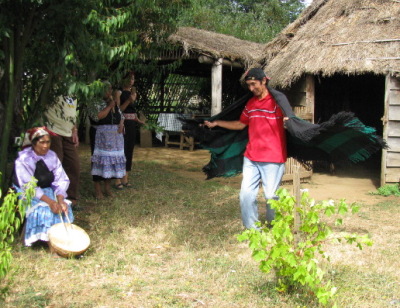 |
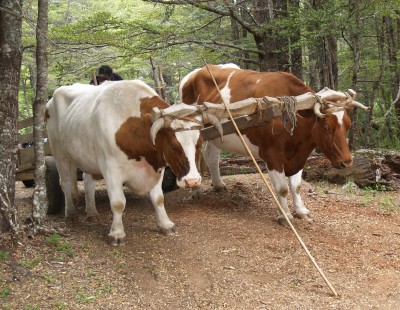 |
We also toured
the garden that provided most of their food. Many of the veggies
were similar to the ones we grow.
While we were there a
farmer and his two oxen went by hauling logs. We stopped him and
took pictures. The oxen were tied to the yoke at the horns and the
driver, who was in front of the oxen, used a long pole in the center
of the yoke to guide them. |
|
Then we drove a long
way on a nice four-lane highway to Valdivia. Before we went into
Valdivia we stopped at an agricultural station of Universidad Austral
(south) to see the experiments in potato growth. We tasted a variety
of papas (potatoes); the professor gave us an over view of what he
does, and we then went out to the fields where he grows different
types of potatoes. Very few of the varieties are grown in the U.S.
Most are old varieties that he has found on the island of Chiloe.
There is a big debate in South America to see where the first potato
was grown, Chile or Peru. |
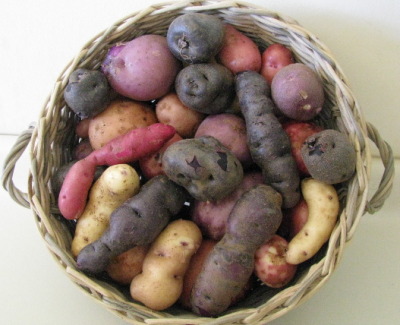 |
|
After the tour we went
into a round out building and had a barbeque with fresh salad (corn,
tomatoes, beets, etc), steak and of course potatoes. The grill in
this place was huge and a chef and his crew prepared the food for us.
Yum, Yum.
 |
After we ate we drove
into Valdivia and to our hotel, Hotel Naguilan. Our room over looked
the river and it was beautiful.
|
|
Valdivia is a city in southern Chile and is named after its founder Pedro de Valdivia. It is located
at the confluence of the Calle-Calle, Valdivia and Cau-Cau Rivers. Since October 2007, Valdivia is the capital of the newly
created Los Rios Region and is also the capital of Valdivia Province. |
|
After a long warm day we watched
the sunset and enjoyed the cool breezes. |
|













